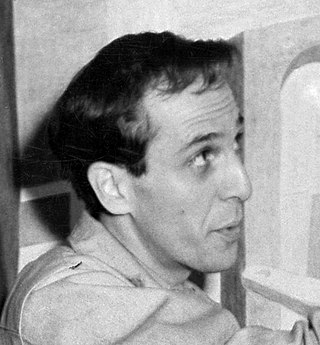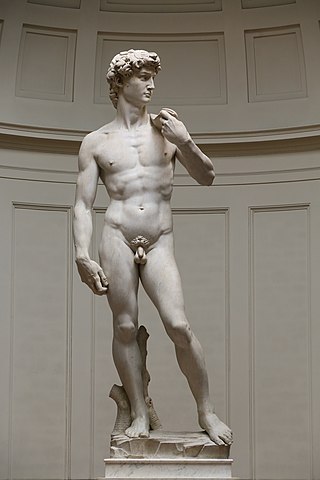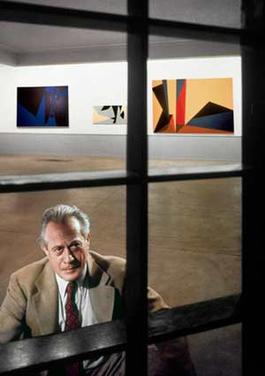Abstract expressionism is a post–World War II art movement in American painting, developed in New York City in the 1940s. It was the first specifically American movement to achieve international influence and put New York at the center of the Western art world, a role formerly filled by Paris.

Frank Helmut Auerbach is a German-British painter. Born in Germany, he has been a naturalised British subject since 1947. He is considered one of the leading names in the School of London, with fellow artists Francis Bacon and Lucian Freud.

Elaine Marie Catherine de Kooning was an Abstract Expressionist and Figurative Expressionist painter in the post-World War II era. She wrote extensively on the art of the period and was an editorial associate for Art News magazine.

Leon Golub was an American painter. He was born in Chicago, Illinois, where he also studied, receiving his BA at the University of Chicago in 1942, and his BFA and MFA at the Art Institute of Chicago in 1949 and 1950, respectively.

Philip Guston, was a Canadian American painter, printmaker, muralist and draftsman. Early in his five decade career, muralist David Siquieros described him as one of "the most promising painters in either the US or Mexico," in reference to his antifascist fresco The Struggle Against Terror, which "includes the hooded figures that became a lifelong symbol of bigotry for the artist." "Guston worked in a number of artistic modes, from Renaissance-inspired figuration to formally accomplished abstraction," and is now regarded one of the "most important, powerful, and influential American painters of the last 100 years." He also frequently depicted racism, antisemitism, fascism and American identity, as well as, especially in his later most cartoonish and mocking work, the banality of evil. In 2013, Guston's painting To Fellini set an auction record at Christie's when it sold for $25.8 million.

John Currin is an American painter based in New York City. He is most recognised for his technically proficient satirical figurative paintings that explore controversial sexual and societal topics. His work shows a wide range of influences, including sources as diverse as the Renaissance, popular culture magazines, and contemporary fashion models. He often distorts or exaggerates the erotic forms of the female body, and has stressed that his characters are reflections of himself rather than inspired by real people.

Patrick Heron was a British abstract and figurative artist, critic, writer, and polemicist, who lived in Zennor, Cornwall.

Glennray Tutor is an American painter who is known for his photorealistic paintings. He is considered to be part of the Photorealism art movement. His paintings are immersed with bright colors, nostalgic items, metaphor, and with a complete focus on detail. Tutor is a graduate of the University of Mississippi where he received his Bachelor of Arts degree in Art and English in 1974 and his Master of Fine Arts degree in Painting in 1976.

Norman Wilfred Lewis was an American painter, scholar, and teacher. Lewis, who was African-American and of Bermudian descent, was associated with abstract expressionism, and used representational strategies to focus on black urban life and his community's struggles.

The nude, as a form of visual art that focuses on the unclothed human figure, is an enduring tradition in Western art. It was a preoccupation of Ancient Greek art, and after a semi-dormant period in the Middle Ages returned to a central position with the Renaissance. Unclothed figures often also play a part in other types of art, such as history painting, including allegorical and religious art, portraiture, or the decorative arts. From prehistory to the earliest civilizations, nude female figures are generally understood to be symbols of fertility or well-being.

Lorser Feitelson (1898–1978) was an artist known as one of the founding fathers of Southern California-based hard-edge painting. Born in Savannah, Georgia, Feitelson was raised in New York City, where his family relocated shortly after his birth. His rise to prominence occurred after he moved to California in 1927.
Douglas Arthur Peter Field, known as Duggie Fields, was a British artist who resided in Earls Court, London.
Amnon David Ar is an Israeli painter. He studied at the Arts and Crafts Municipal High School of Tel Aviv until the age of eighteen. After completing his compulsory military service, he studied anatomy with Oswald Adler. He then spent one year at the Bezalel Academy of Arts and Design in Jerusalem, before leaving, because he felt that both the training and the curriculum didn't provide the skills and knowledge he was looking for. For this reason, Ar decided to organize his own studies, and spent a further year learning painting and drawing with Abraham Bykov. By studying with older artists, Ar has trained himself in a traditional way, and can, at least in part, be considered an autodidact. During his studies, Ar worked as a chief illustrator and caricaturist at Maariv and also at Yedioth Tikshoret. Today, Ar also teaches painting and drawing, with the express intention of passing on to the next generation of artists, his experience, and with it his understanding of the artistic skills of the past. In 2014 Ar moved to Berlin, where he has his studio and teaches.
Carol Diehl is an American artist, art critic and poet. In addition to her writing, most recently appearing in her blog Art Vent, she is best known for her paintings, which have often documented daily life in a manner described as diaristic, even compulsive, using dense, painterly, often indecipherable words, numbers and symbols in grid or geometric frameworks. Diehl has also been a prolific art critic, having contributed features and reviews to numerous periodicals, including Art in America, ARTnews, and Art + Auction, as well as to books and artist catalogues. In the 1990s, she became active in New York's performance poetry scene. Diehl lives in New York City and southwestern Massachusetts. She has two sons, Matt Diehl and Adam Diehl.

Raymond P. Spillenger was an American painter associated with the New York School.
Sedrick Ervin Huckaby (1975) is an American artist known for his use of thick, impasto paint to create murals that evoke traditional quilts and his production of large portraits that represent his personal history through images of family members and neighbors.

John Himmelfarb is an American artist, known for idiosyncratic, yet modernist-based work across many media. Diverse influences ranging from Miró, Matisse and Picasso to Dubuffet, New York school artists like de Kooning, Guston, and Pop artists inform his work, described by critics and curators as chaotically complex and tightly constructed. He often employs energetic, gestural line, dense patterns of accumulated shapes, and fluid movement between figuration and abstraction, using strategies of concealment and revelation to create a sense of meaning that is both playful and elusive. His work is also unified by "a circulating library" of motifs and organizing structures, such as geographic and urban mapping, abstracted natural and industrial forms, and language systems. Assessing him at mid-career, New Art Examiner’s Andy Argy wrote "Himmelfarb’s art is original […] His unabashed immersion in graphic art, emphasizing drawing over painting, has earned him an important place among artists who make drawings into major aesthetic statements." Himmelfarb next turned to monumental paintings that critic Christopher Moore called joyful, luminous, and frenetic pyrotechnical displays. In 2006, he began to devote considerable studio time to sculpture that curator Gregg Hertzlieb described as an expression of the "human need for play and (our) enduring fascination with metamorphosis and transformation."
Allie McGhee is a Detroit-based African American painter and pillar of the Detroit art community since the 1960s. Allie McGhee attended Cass Technical High School in Detroit, MI, and completed his undergraduate work at Eastern Michigan University in 1965.
Bruno Civitico was an Italian-born American painter, draughtsman and teacher. He is widely considered to be "a major player in the development of Classicism," and "one of the most important artists of the Neoclassical Figurative revival movement."

Peter Beresford Williams was an American painter, educator, and social activist. His paintings have been described by writer and artist William Eckhardt Kohler as "in no particular order: hallucinogenic, acerbic, pained, beautiful, confessional, obsessive, critical, jarring, wild, weird, and profoundly human". In 2020, Williams received the Artists' Legacy Foundation Artist Award.













